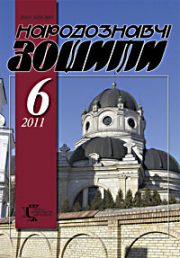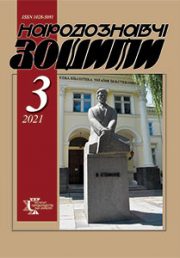The Ethnology Notebooks. 2024. № 3 (177), 641—650
UDK 930.2:391-055.2(477.83-25=161.2=162.1=19)”15/16″
DOI https://doi.org/10.15407/nz2024.03.641
ZAMOSTIANYK Iryna
- ORCID ID https://orcid.org/0000-0003-4696-350X
- Candidate of historical sciences, Acting Academic Secretary
- of the Institute of Ethnology
- The National Academy of Sciences of Ukraine,
- 15, Svobody Avenue, 79000, Lviv, Ukraine,
- Contacts: e-mail: Zamostianyk@nas.gov.ua
Abstract. Introduction. One of the important components of material culture is clothing. Exterior influences and preservation of the traditions of those ethnic communities that lived in the city are best traced in the clothing of the Lviv bourgeoisie during the late Middle Ages and early modern times. This study is relevant because despite the various aspects of city life, clothing of the Lviv bourgeoisie remains unattended by historians. At the same time, сitizens’ clothing is an element of everyday culture that leads to understanding of ethno-cultural processes in the city.
Problem Statement. The purpose of the article is to analyze the clothing of the Lviv townspeople at the end of the 16th — the first half of the 17th century. We will do this in the context of the functioning of different ethno-cultural communities and international connections of the city through the processing of archival documents and introduce them to scientific use.
Purpose. The object of the research is the clothing of Lviv townspeople, the subject is the components of clothing in their reflection in a complex of written sources.
Methods. The methodological basis was the research based on the principle of historicism, scientific objectivity and systematicity. We used analysis as the selected scientific method, data synthesis, description. Special scientific methods were also applied: comparative-historical, typological, historical-reconstructive. Сharacterization of Lviv townspeople’s clothing as a manifestation of the multiethnic composition of the urban environment was made thanks to a comparative-historical method. The typological method has raised a large number of previously unanswered questions. In addition, cross-cultural analysis was applied. Such research methods have made it possible to fully solve the tasks we have set out.
Results. For the first time in the article a historical and ethnographic study of women’s clothing was carried out on the example of Lviv, a city dating from the 16th century was the largest in Ukraine. The article shows the specifics of local features of the clothing of the townspeople of the late 16th — first half of the 17th c. in the context of multiethnic Lviv. New sources on this issue have been brought to scientific circulation. In particular, court records, wills and property descriptions. The author was able to find out that the clothing of the townspeople was distinguished by its variety in shape, purpose and color. The influence of the fashion trends of the countries of Western Europe and the East on the attire of the townspeople of Lviv is analyzed in the article. The author also examined the effects of the suburban peasant element on the clothing of the Lviv townspeople.
Keywords: Material Culture, Lviv, the Ukrainians, the Poles, the Armenians, ethnicity, testaments women’s clothes, tissue, litnyk, shirt, rantuch.
Received 5.06.2024
REFERENCES
- Lozinski, W. (1890). Patricians and Lviv bourgeoisie in the 16th and 17th centuries. Lviv: Gubrynowicz i Schmidt [in Polish].
- Krypiakiewicz, I. (1905). Materials on the History of Lviv Trade. Notes of the Shevchenko Scientific Society (Vol. LXV, book 3, pp. 1—46) [in Polish].
- Gronsky, Y. (1984). Weekdays of medieval Lviv. Zovten, 7, 95—101 [in Ukrainian].
- Nishpor, M. (2007). The daily life of the Italians in Lviv increases the XVI — in the first half of the XVII century. (Send notice of conservation and inventory of property). Ukrainian Historical Journal, 4, 51—69 [in Ukrainian].
- Petryshak, B. (2011). «Knight of the Feather and the Calamari» — the clerk of the city of Lviv Wojciech Zymnicki (1583—1639). Lviv [in Ukrainian].
- Zayats, O. (2008). Granting of Urban Citizenship to the Non-Catholic Population of Lviv in 1501—1571 Scientific Notebooks of the Faculty of History (Issue 5—6, pp. 42—48) [in Ukrainian].
- (2005). Album civium Leopoliensium. Registers of admissions to the city law in Lviv 1388—1783 (Vol. 1, 2). Poznan; Warsaw [in Polish].
- Hoshko, T. From the History of Magdeburg Law in Lviv (XIII—XVII centuries). Retrieved from: https://map.lviv.ua/statti/goshko.html [in Ukrainian].
- Golovatsky, J. (1868). About the clothes or folk clothing of the Rusyns or Russians in Galicia and Northern Hungary. Petrograd: In the printing house of A.A. Kraevsky [in Ukrainian].
- Golovatsky, J. (1877). About folk clothes and outfits of the Rusyns or Russians in Galicia and Northern Hungary. S. Peterburg: Typography of V. Kirschbaum [in Ukrainian].
- Zamostianyk, I. (2016). Menswear of Lvivs citizens at the end of XVIth — first half of XVIIth century. Ethnology notebooks, 4, 873—883 [in Ukrainian].
- Vuytsyk, V., & Lipka, R. (1987). Meeting with Lviv. Guidebook. Lviv: Kameniar [in Ukrainian].
- Kazantseva, T. (2005). Factual analysis of the application of textures of silt and stone in the formation of dominant directions in the architecture of Lviv XVI — the first half of XX centuries. Notes of the Shevchenko Scientific Society. Proceedings of the Commission on Architecture and Urban Planning (Vol. CCXLIX, pp. 177—199)Lviv [in Ukrainian].
- Zamostianyk, I. (2009). Testament of Lviv architect Paul Roman (1618). Ukrainian Archeographic Yearbook, 13/14, 457—466 [in Ukrainian].
- Motylewicz, J. (2005). Przemyshl Society in the 16th and 17th centuries. Rzeszow: Rzeszow University Press [Polish].
- Kryvonos, V. (1996). Trade in Levantine silk in Lviv in the XVI — the middle of the XVI century. Ukraine in the past, 8, 117—135 [in Ukrainian].
- Gloger, Z. (1900). Old Polish encyclopedia. Illustrated (Vol. I). Warsaw: Print by P. Laskauer and W. Babicki [Polish].
- Central State Historical Archive of Ukraine in Lviv. F. 52. Op. 2. Case 23. Book of other Government products and protocols. 1595—1596 years [in Polish].
- Central State Historical Archive of Ukraine in Lviv. F. 52. Op. 2. Case 37. Book of records of inducts and protocols of the Government of the Council. 1622 year [in Polish].
- Central State Historical Archive of Ukraine in Lviv. F. 52. Op. 2. Case 394. A book of records of resolutions, complaints, debts, witness statements and other documents. 1616—1619 years [in Polish].
- Lozinski, W. (1978). Polish life in the past centuries. Krakow [in Polish].
- Gutkowska, M. (1932). History of clothing with an atlas containing 349 figures and XI tables. Lviv; Warsaw: United cartographic factories and publishers T.S.N.W — S.A. [in Polish].
- Turnau, I. (1975). Clothing leather in Poland of the 16th—18th centuries. Wroclaw; Warsaw; Krakow; Gdansk: Publishing House of the Polish Academy of Sciences [in Polish].
- Central State Historical Archive of Ukraine in Lviv. F. 52. Op. 2. Case 26. Book of records of inducts and protocols of the Government of the Council 1601—1608 years [in Polish].
- Isaevich, I.D., Kupchinsky, O.A., & Matsuk, O.Y. (1975). The first printer Ivan Fedorov and his followers in Ukraine (XVI — first half of XVI century). Collection of documents. Kyiv: Naukova dumka [in Ukrainian].
- Gloger, Z. (1901). Old Polish encyclopedia. Illustrated (Vol. ІІ). Warsaw: Printing of P. Laskauer and W. Babicki [in Polish].
- Central State Historical Archive of Ukraine in Lviv. F. 52. Op. 2. Case 520. Book of inductees of the Armenian court. 1611—1615 years [in Polish].
- Linde, Samuela Bogumile. (1807). Polish dictionary (Vol. 1, p. 1). Warsaw: Printing house XX. Piiarow, at the author’s, 1807—1814; Warsaw: Piotr Laskauer and S. Printing [in Polish].
- Central State Historical Archive of Ukraine in Lviv. F. 52. Op. 2. Case 39. Book of records of inducts and protocols of the Government of the Council. 1624 years [in Polish].
- Gloger, Z. (1902). Old Polish encyclopedia. Illustrated (Vol. IІІ). Warszawa: Warsaw: Piotr Laskauer and S-ki [in Polish].
- Central State Historical Archive of Ukraine in Lviv. F. 52. Op. 2. Case 25. Book of other Government products and protocols. 1599—1600 years [in Polish].
- Stelmashchuk, G., Isaevich, Ya.D., Yasinovsky, Yu.P. (Eds.).(2001). Clothes. History of Ukrainian Culture: in 5 vol. Ukrainian culture of the 13-th — first half of the 17-th centuries (Vol. 2, pp. 123—133). Kyiv: Naukova dumka [in Ukrainian].
- Central State Historical Archive of Ukraine in Lviv. F. 52. Op. 2. Case 36. Book of records of inducts and protocols of the Government of the Council. 1621 year [in Polish].
- Gloger, Z. (1903). Old Polish encyclopedia. Illustrated (Vol. IV). Warsaw: Piotr Laskauer and S-ki [in Polish].
- Central State Historical Archive of Ukraine in Lviv. F. 52. Op. 2. Case 388.Book of records of decisions, complaints, debt obligations, protocols of witness confessions, etc. Documents 1599—1602 years [in Polish].
- Mateiko, K. (1977). Ukrainian folk clothing. Kyiv: Naukova dumka [in Ukrainian].
- Central State Historical Archive of Ukraine in Lviv. F. 52. Op. 2. Case 27. Book of records of inducts and protocols of the Government of the Council. 1604—1605 [in Polish].
- National Library in Warsaw. He cut off special collections. Syg. IV 012371. Acta decretorum advocatialium Armenorum decanatus S. Joannis Baptistae Leopoliensis, ad an [no] 1605 ad an [num]1691 (Vol. 1) (1605—1640) [in Polish].
- Central State Historical Archive of Ukraine in Lviv. F. 52. Op. 2. Case 525. Book of Inductions of the Armenian Court. 1638—1639 рр. [in Polish].
- Central State Historical Archive of Ukraine in Lviv. F. 684. The proto-abumenate of the monasteries of St. St. Basil the Great, Lviv 1772—1946. Op. 1. Case 2212. Grigorova Marusa’s gift record in favor of the monastery 1652 [in Polish].
- Archive of southwestern Russia, which is issued by the commission for the study of ancient acts, which is in the Kiev, Podolsk and Volyn Governor-General. Acts that belong to the Stavropolsky Brotherhood of Lviv (Vol. 11, p. 1). Kyiv: Typography of the Imperial University of St. Vladimir, 1904 [in Polish].
- Central State Historical Archive of Ukraine in Lviv. F. 52. Op. 2. Case 529. Book of inductees of the Armenian court. 1651—1652 years [in Polish].
- Central Archives of Historical Records in Warsaw. Czolowski’s collection. Case 394 [in Polish].
- Central State Historical Archive of Ukraine in Lviv. F. 52. Op. 2. Case 389. Book of records of resolutions, complaints, debts, witness statements and other documents. 1603—1605 years [in Polish].
- Sribnyj, F. (1913). Studios on the organization of the Lviv Stavropol region from the end of the 16-th to the half of the 17-th century. Notes of the Shevchenko Scientific Society (Vol. CXV, pp. 29—76). Lviv [in Ukrainian].
- Bystron, J. (1960). History of customs in old Poland. 16th—18th century (Vol. 1). Warsawa: National Publishing Institute [in Polish].
- Central State Historical Archive of Ukraine in Lviv. F. 52. Op. 2. Case 30. Book of records of inducts and protocols of the Government of the Council. 1610—1611 years [in Polish].
- Linde, Samuela Bogumile. (Ed.). (1812). Polish dictionary (Vol. 3). Warsaw: Printing house XX. Piiarow, from the author, 1807—1814; Warsaw: At the author [in Polish].
- Linde, Samuela Bogumile. (Ed.). (1809). Polish dictionary (Vol. 2, p. 1). Warsaw: Printing house XX. Piiarow, at the author’s, 1807—1814; Warsaw: At the author’s [in Polish].
- Central State Historical Archive of Ukraine in Lviv. F. 52. Op. 2. Case 393. Book of records of resolutions, complaints, debts, witness statements and other documents. 1614—1615 years [in Polish].
- Gutkowska-Rychlewska, M. (1968). History of ubiops. Wroclaw; Warsawa; Krakow: Ossolinski National Institute [in Polish].
- Bartkiewicz, M. (1974). Clothing and interiors of burgher houses in Poland in the second half of the 16th and in the 17th century. Wroclaw; Warsawa; Krakow; Gdansk: Publishing House of the Polish Academy of Sciences [in Polish].
- Krvavich, D., & Stelmashuk, G. (1988). Ukrainian folk clothing of the 17th — early 19th centuries in Y. Glogowski’s watercolors. Kyiv: Naukova dumka [in Ukrainian].






